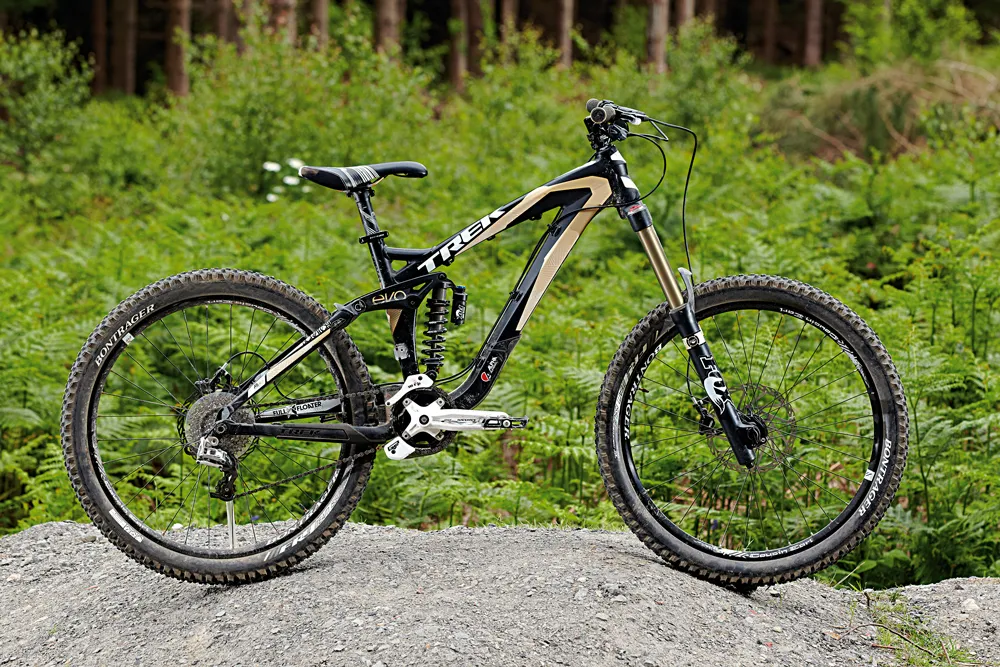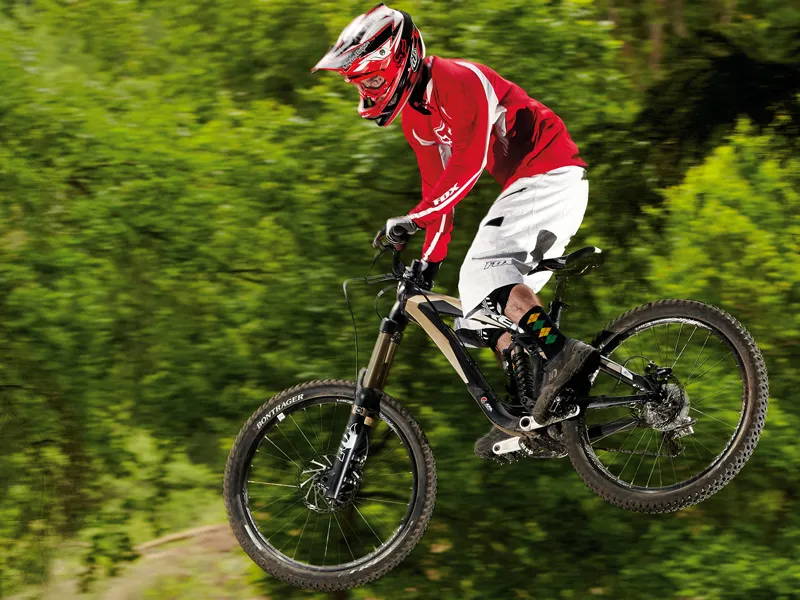The Scratch has been holding down the freeride ranks for Trek for the last couple of years. Now it’s been split into two versions – the all-mountain air shock version, and the Gravity, which is the coil shock-shod bike you see here. It’s bang-on for what we were looking for in this test and it proves more versatile than you might think.
The overall feel of the Scratch really is a bit on the freeride side, but with 180mm (7in) travel at each end to help you recover from any mistakes. It’s light and easy to trick, and the low-slung top tube doesn’t get in the way of your legs when it comes to throwing tables down. It’s an all-rounder, equally good at pulling off freeride moves or nailing a steep technical downhill section.
Ride & handling: A ‘freeride’ bike capable of holding its own on the super steep downhills too
The Scratch immediately feels short for a 17.5in frame, due to the 558mm top tube and 710mm bar with 50mm rise. It has more of a freeride feel than a downhill rig. We tried changing to a 750mm wide, low-rise bar which helped a lot with the lower, wider feel for flat out downhill shredding. The 439mm chainstays keep the rear end at a good balance between lively and stable, and contribute to the 1,154mm wheelbase, as does the steep 74-degree seat tube angle. The seat tube angle does wonders for keeping you central on the bike with the saddle up too.
This all translates to a stable package that feels compact enough, and is sufficiently light to really get moving in the air. The rear suspension works well over big, hard compressions, and even pedals quite efficiently thanks to the custom tune on the shock. Trek's unique tuning on the Fox 36 Van R fork and a Van RC coil do a great job of keeping the trail firmly under control.
It did sometimes choke on repetitive square-edge hits though, and had a tendency to hit the compression and lose traction, as if the rear wheel was bouncing off the ground. So we changed the spring for a slightly lighter one and ran a little more sag than prescribed which seemed to sort the issue, but did decrease pedalling efficiency a bit. That said, the Trek was still the most pedal efficient bike on test.
With the saddle up, we nailed the XC test loop in a respectable time, thanks to the steep seat tube angle and even with the 65-degree head angle – not something we were expecting to do on a ‘freeride’ bike, especially one capable of holding its own on the super steep downhills too. The Fox tuned Van R fork, despite lacking on any compression adjustment, works amazingly well. It’s a pretty simple unit, with no multitude of knobs to get confused over – just dial in the rebound and ride.
The stiff 36 chassis, combined with the frame’s E2 tapered head tube, helps translate any movement through the bars into motion on the trail, and the fork was predictable and consistent. Bontrager’s own high volume FR4 tyres roll super fast and grip pretty well on hardpack too. They even performed well in loamy stuff, where we weren’t expecting them to do so well.
Frame: Steep seat angle helps towards all-round ability
For this year, Trek have taken the 142 x 12mm axle standard on board, but kept the rest of the frame spec the same as in 2010. Trek’s Alpha Red aluminium is formed into the complicated shapes used in the Scratch’s tubeset, meaning the frame is kept light, with material in all the right places. It’s got ISCG mounting tabs and a bolt-on front mech mount. It comes complete with a Maxle for fast rear wheel removal too.
The Mino Link adjustable geometry gives 0.5 degrees of head angle adjustment and 10mm of bottom bracket height adjustment. If you prefer a 135mm quick-release though, the bike comes with adapters for the dropouts to run a 135mm wheel so you can switch if you want to.
Equipment: Specced with care
Trek specced the Scratch almost as we would. The Fox 36 Van R fork with 180mm (7in) travel and a Van RC coil shock, both with Trek’s unique tuning, provide the bump control. A SRAM X7 shifter and an X9 short cage mech do the shifting duties. The MRP G2 chainguide is a welcome part of the spec too, running a 36t chainring.
It’s worth mentioning that the Trek was the only bike on test to arrive with pedals, and grippy ones at that. Bontrager, Trek’s component brand, bring the finishing kit, with bar, stem, seat, post and a Cousin Earl wheelset. There’s even enough head tube left to customise your front end height, giving a good amount of adjustment, from super low to higher than average.

